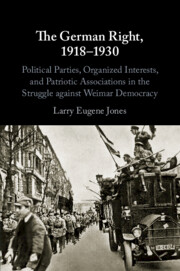 The German Right, 1918–1930
The German Right, 1918–1930 Book contents
- The German Right, 1918–1930
- The German Right, 1918–1930
- Copyright page
- Dedication
- Contents
- Figures
- Acknowledgments
- Abbreviations
- Introduction
- 1 Revolution and Realignment
- 2 Infrastructure of the German Right
- 3 Forging a Conservative Synthesis
- 4 Growth and Consolidation
- 5 The Radical Right
- 6 1923 – A Missed Opportunity?
- 7 From Triumph to Schism
- 8 Stabilization from the Right?
- 9 Paladins of the Right
- 10 A Resurgent Nationalism
- 11 The Road Back to Power
- 12 The Burden of Responsibility
- 13 From Defeat to Crisis
- 14 Reverberations and Realignment
- 15 The Chimera of Right-Wing Unity
- 16 Schism and Fragmentation
- 17 The Brüning Gambit
- 18 The September Earthquake
- Epilogue
- Select Bibliography
- Index
18 - The September Earthquake
Published online by Cambridge University Press: 21 March 2020
- The German Right, 1918–1930
- The German Right, 1918–1930
- Copyright page
- Dedication
- Contents
- Figures
- Acknowledgments
- Abbreviations
- Introduction
- 1 Revolution and Realignment
- 2 Infrastructure of the German Right
- 3 Forging a Conservative Synthesis
- 4 Growth and Consolidation
- 5 The Radical Right
- 6 1923 – A Missed Opportunity?
- 7 From Triumph to Schism
- 8 Stabilization from the Right?
- 9 Paladins of the Right
- 10 A Resurgent Nationalism
- 11 The Road Back to Power
- 12 The Burden of Responsibility
- 13 From Defeat to Crisis
- 14 Reverberations and Realignment
- 15 The Chimera of Right-Wing Unity
- 16 Schism and Fragmentation
- 17 The Brüning Gambit
- 18 The September Earthquake
- Epilogue
- Select Bibliography
- Index
Summary
Chapter 18 discusses the fateful elections of 14 September 1930 from the perspective of the German Right and the various factions on the Right that were vying for power. It focuses first of all on the efforts of the young conservatives who reorganized themselves into the Conservative People’s Party in the hopes of uniting those who had left the DNVP into a single political front. But these efforts, which enjoyed strong support from Paul Reusch and the German industrial establishment, evoked little interest from the leaders of the CNBLP and CSVD, both of whom were determined not to compromise the uniqueness of their own political appeal by entering into close ties with other political parties. In the meantime, Hugenberg and the DNVP leadership tried to organize their campaign around the mantra of anti-Marxism but misread, as did most of the other parties in the middle and moderate Right, the threat that National Socialism posed to their party’s electoral prospects. As a result, the Nazis were able to capitalize upon the disunity of the non-Nazi Right to score a victory of epic proportions that gave the NSDAP fourteen percent of the popular vote and 107 Reichstag mandates.
Keywords
- Type
- Chapter
- Information
- The German Right, 1918–1930Political Parties, Organized Interests, and Patriotic Associations in the Struggle against Weimar Democracy, pp. 555 - 588Publisher: Cambridge University PressPrint publication year: 2020
